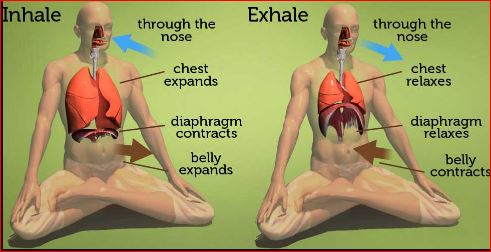What Is Diaphragmatic Breathing?
Unknown to many people, there are different types of breathing that humans perform. One of these is diaphragmatic breathing and involves the use of the diaphragm muscle. It is said that this type of breathing promotes relaxation and benefits those with a chronic obstructive pulmonary disorder (COPD) [1, 2, 3, 4].
Mechanism of Respiration
The action of breathing or respiration occurs as a result of the changes in the pressure of the air inside the lungs and the atmospheric pressure. Inhalation involves contraction of the intercostal muscles and diaphragm to expand the chest cavity.
The diaphragm moves downwards while the muscles of the intercostal ribs move upwards and out. The expansion of the chest cavity will result in the reduction in the air pressure from the lungs.
Due to the lower pressure, air from the outside would rush inside the lungs to equalize the pressure. Upon expiration, the diaphragm and the intercostal muscles would return to their resting position and decrease the size of the abdominal cavity.
This will increase the air pressure inside the lungs and would force the air out in the atmosphere [5]. Figure 1 shows an illustration of the mechanism of breathing.

Figure 1- The mechanism of breathing
Types of breathing
There are different types of breathing that a human can perform. They differ in the muscles that are used to expand the respiratory cavity [1].
- Eupnea or normal quiet breathing involves the contraction of both the intercostal muscles and the diaphragm.
- Diaphragmatic breathing only involves the contraction and relaxation of the diaphragm to initiate inhalation and exhalation. This type of breathing is deeper than eupnea.
- Costal breathing only utilizes the intercostal muscles for respiration. This breathing is shallower than normal breathing.
- Hyperpnea or forced breathing require the contractions of muscles for both inhalation and expiration. The muscles that are involved in this breathing are the diaphragm, intercostal muscles and accessory muscles of the lungs.
Among these types of breathing, it is said that diaphragmatic breathing is the most beneficial for healthy breathing. It has several health benefits that other types of breathing does not offer [6].
Benefits of Diaphragmatic Breathing
Engaging the diaphragm in breathing is preferred because of the several health benefits this provide to the body [6].
More efficient gas exchange
The contraction of the diaphragm during respiration promotes a more efficient exchange of oxygen and carbon dioxide. About two-thirds of the total gas exchange occurs in the bottom lobes of the lungs. Oxygenation is more efficient when the muscles of the diaphragm are used in respiration [6].
Rebalances the ANS
Performing diaphragmatic breathing reduces the heart rate and breathing rate. It changes the sympathetic fight or flight response of the body to a more relaxing parasympathetic response [6].
Less tension in neck muscles
Diaphragmatic breathing reduces the tension and tightness in the muscles of the neck and shoulders and causes a relaxation of these muscles [6].
Good posture
Engaging the diaphragm in breathing can contribute to the development of good posture and improve the strength of the core muscles [6].
Aid in bodily functions
The contraction and relaxation of the diaphragm massages the organs in the abdomen. The movement of the diaphragm aids in digestion and helps in the drainage of the lymphatic system [6].
Diaphragmatic Breathing Technique
The technique of performing the correct diaphragmatic breathing is as follows [2]:

While lying down
Look for a bed or a flat surface where you can lie on your back. The knees should be bent and the head should be supported with pillows. Another pillow can be placed under the legs for additional support. One hand will be placed in the upper chest while the other below the rib cage.
The placement of the hands will allow the diaphragm to be felt while it contracts and relaxes. During inspiration, the stomach should move out against the hand below the rib cage. The hand on the upper chest should stay as still as possible.
Upon expiration, the muscles of the stomach should be tightened and the air should be released through pursed lips. The hand on the upper chest should stay still on this part as well [2].
While sitting down
Sit comfortably with the knees bent and the head, neck, and shoulders relaxed. One arm should be placed on the upper chest and the other hand placed below the rib cage in order to feel the movement of the diaphragm. Inhale slowly through the nose and the stomach should move out against the hand.
The hand placed on the upper chest should not move. Expiration should be done by tightening of the stomach muscles and letting them fall forward as the air is released through pursed lips. The hand placed on the upper chest should stay as still as possible [6].
Performing diaphragmatic breathing may require an increased effort at first and may be tiring. But with continued practice, this would become easier and will be automatic [6]
References
- Boundless. (2016, May 27). Types of Breathing. Boundless Biology: https://www.boundless.com/biology/textbooks/boundless-biology-textbook/the-respiratory-system-39/breathing-221/types-of-breathing-837-12082/
- Cleveland Clinic. (2016). Diaphragmatic Breathing. Cleveland Clinic: http://my.clevelandclinic.org/health/articles/diaphragmatic-breathing
- Kidd, S. (2017). How To Activate Your Diaphragm To Improve Breathing And Performance. Retrieved from Breaking Muscle: https://breakingmuscle.com/learn/how-to-activate-your-diaphragm-to-improve-breathing-and-performance
- Normal Breathing. (2017). Diaphragmatic Breathing: Techniques and Instructions. Retrieved from Normal Breathing: http://www.normalbreathing.com/learn-8-diaphragmatic-breathing.php
- Winter, J. (2014, July 23). Five health benefits of breathing with your diaphragm. Retrieved from Breathing Remedies: http://www.breathingremedies.co.uk/2014/07/23/five-health-benefits-of-breathing-with-your-diaphragm/
- Teach PE. (2017). Mechanics of Breathing. Teach PE: http://www.teachpe.com/anatomy/breathing.php
